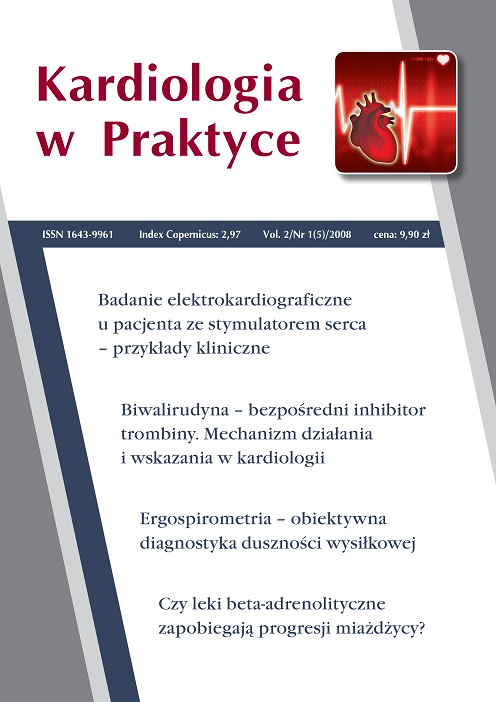Ergospirometria – obiektywna diagnostyka duszności wysiłkowej Artykuł przeglądowy
##plugins.themes.bootstrap3.article.main##
Abstrakt
Duszność wysiłkowa jest podstawowym objawem niewydolności serca i ważnym czynnikiem rokowniczym. Określenie zużycia tlenu na szczycie wysiłku oraz na progu beztlenowym pozwala na dokładną i obiektywną ocenę wydolności układu krążenia. U chorych z niewydolnością serca stwierdza się nieadekwatny do wysiłku przyrost częstości oddechów i objawy nadmiernej wentylacji. Choroby towarzyszące mogą wywierać niezwykle istotny wpływ na przebieg niewydolności serca, ponadto utrudniają jej rozpoznanie oraz stwarzają konieczność zmiany sposobu leczenia. Ergospirometria umożliwia najbardziej obiektywną ocenę stanu pacjenta z dusznością wysiłkową: ocenę zaawansowania niewydolności serca, diagnostykę różnicową etiologii duszności wysiłkowej oraz ocenę skuteczności leczenia kardiologicznego i pneumonologicznego.
Pobrania
##plugins.themes.bootstrap3.article.details##

Utwór dostępny jest na licencji Creative Commons Uznanie autorstwa – Użycie niekomercyjne – Bez utworów zależnych 4.0 Międzynarodowe.
Copyright: © Medical Education sp. z o.o. This is an Open Access article distributed under the terms of the Attribution-NonCommercial 4.0 International (CC BY-NC 4.0). License (https://creativecommons.org/licenses/by-nc/4.0/), allowing third parties to copy and redistribute the material in any medium or format and to remix, transform, and build upon the material, provided the original work is properly cited and states its license.
Address reprint requests to: Medical Education, Marcin Kuźma (marcin.kuzma@mededu.pl)
Bibliografia
2. Fleg J.L., Balady G.J. et al.: Assessment of functional capacity in clinical and research applications. An Advisory from the Committee on Exercise, Rehabilitation, and Prevention, Council on Clinical Cardiology, American Heart Association. Circulation 2000, 102: 1591- 1597.
3. Kavanagh T., Mertens D.J., Hamm L.F. et al.: Prediction of Long-Term prognosis in 12 169 men referred for cardiac rehabilitation. Circulation 2002 Aug 6, 106(6): 666-71.
4. Madsen B.K., Hansen J.F., Sztokholm K.H. et al.: Chronic congestive heart failure. Description and survival of 190 consecutive patients with a diagnosis of chronic congestive heart failure based on clinical signs and symptoms. Eur. Heart J. 1994, 15: 303-310.
5. Robbins M., Francis G., Pashkow F.J. et al.: Ventilatory and heart rate responses to exercise: better predictors of heart failure mortality than peak oxygen consumption. Circulation 1999, 100: 2411-2417.
6. Haywood G.A., Rickenbacher P.R., Trindade P.T. et al.: Analysis of deaths in patients awaiting heart transplantation: impact on patient selection criteria. Heart 1996, 75: 455-462.
7. Myers J., Froelicher V.F.: Hemodynamic determinants of exercise capacity in chronic heart failure. Ann. Intern. Med. 1991, 115: 377-386.
8. Weber K.T., Kinasewitz G.T., Janicki J.S. et al.: Oxygen utilization and ventilation during exercise in patients with chronic cardiac failure. Circulation 1982, 65: 1213-1223.
9. Statement on cardiopulmonary exercise testing In chronic hart failure due to left ventricular dysfunction: Recommendations for performance and interpretation Part II: How to perform cardiopulmonary exercise testing In chronic hart failure” Task Force of the Italian Working Group on Cardiac Rehabilitation and Prevention endorsed by Working Group on Cardiac Rehabilitation and Exercise Physiology of the European Society of Cardiology. Eur. J. Cardiovasc. Prev. Rehabil. 2006, 13: 300-311.
10. Markowicz D.H., Sistrom D.M.: Diagnosis of pulmonary vascular limit to exercise by cardiopulmonary exercise testing. J. Heart Lung Transplant. 2004 Jan, 23(1): 88-95.
11. Roca J., Whipp B.J. et al.: Clinical exercise testing with reference to lung disease: indications, standardizations and interpretation strategies. ERS Task Force Report. Eur. Respir. J. 1997, 10: 2662-89.
12. Dahlström U.: Frequent non-cardiac comorbidities in patients with chronic heart failure. Eur. J. Heart Fail 2005, 7: 309-16.
13. Guazzi M., Pontone G., Brambilla R. et al. : Alveolar – capillary membrane gas conductance: a novel prognostic indicator in chronic heart failure. Eur. Heart J. 2002, 23: 467-76.
14. Wierzchowiecki M: „Zaburzenia funkcji układu oddechowego a niewydolność serca – niedoceniany związek?” Komentarz redakcyjny, Kardiologia Polska 2007; 65: 8.
15. Agostoni P., Bussotti M., Cattadori G. et al.: Gas diffusion and alveolar-capillary unit in chronic heart failure. Eur. Heart J. 2006, 27: 2538-43.
16. Rutten F.H., Cramer M.J., Grobbee D.E., et al.: Unrecognized heart failure in elderly patients with stable chronic obstructive pulmonary disease. Eur. Heart J. 2005, 26: 1887-97.
17. Wasserman K., Hansen J.E., Sue D.Y., Whipp B.J., Casaburi R.: Principles of exercise testing and interpretation. 2nd ed. Lea and Febiger, Philadelphia 1994.
18. Rutten F.H., Cronner M.J., Lammers J.W.: Heart failure and chronic obstructive pulmonary disease: An ignored combination? Eur. J. Heart Fail 2006, 8: 706-11.
19. Le Jemtel T.H., Padeletti M., Jelic S.: Diagnostic and therapeutic challenges in patients with coexistent chronic obstructive pulmonary disease and chronic heart failure. J. Am. Coll. Cardiol. 2007, 49: 171-80.
20. Aronow W.S.: Treatment of heart failure in older persons. Dilemmas with coexisting conditions: diabetes mellitus, chronic obstructive pulmonary disease, and arthritis. Congest. Heart Fail 2003, 9: 142-7.
21. Guidelines for the diagnosis and treatment of chronic heart failure. Task Force for the Diagnosis and Treatment of Chronic Heart Failure, European Society of Cardiology. Eur. Heart J. 2001, 22: 1527-1560.
